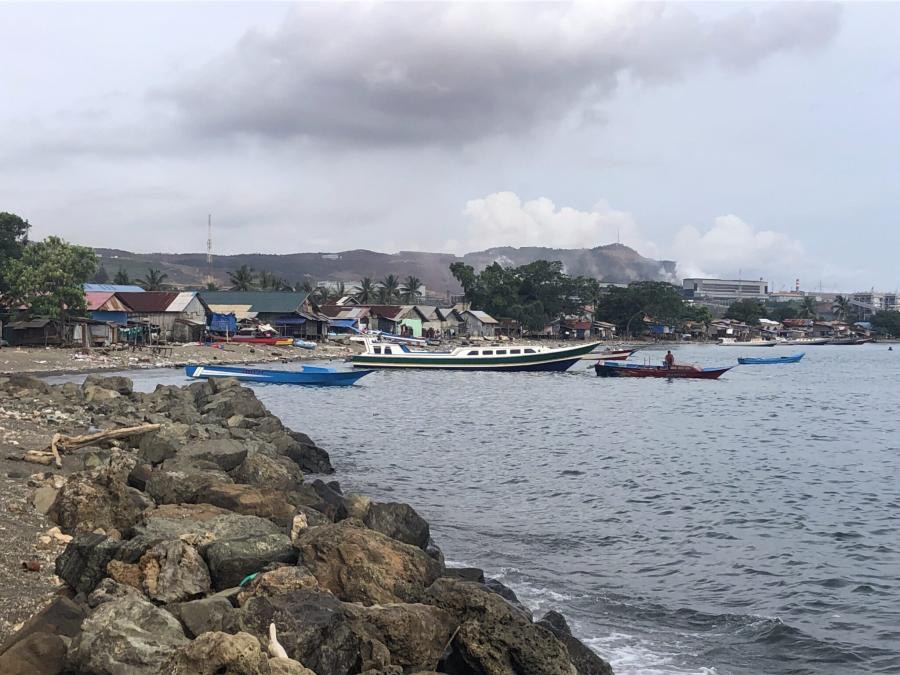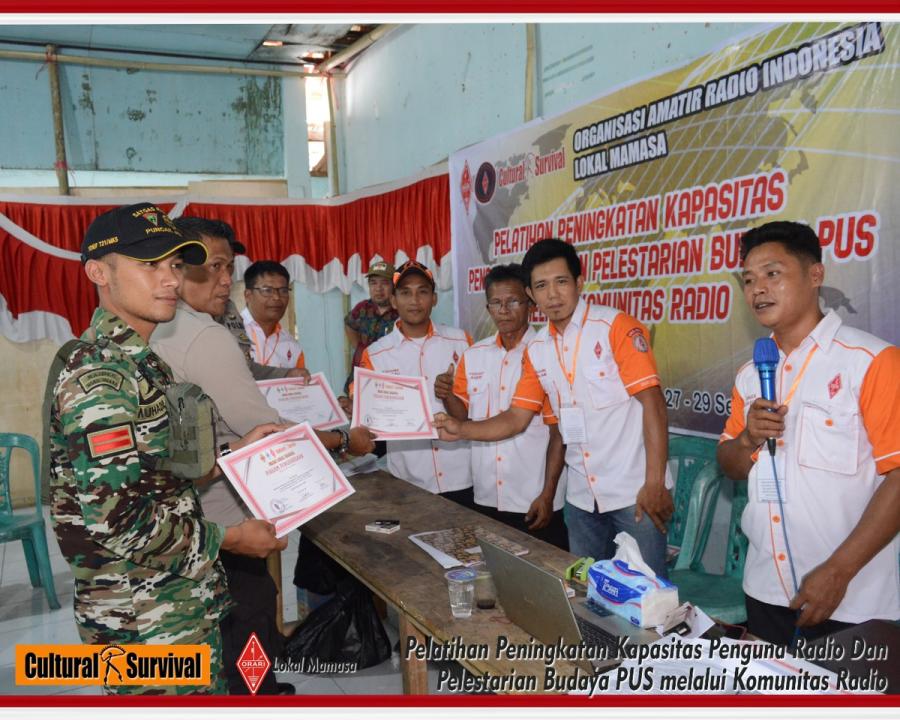The December 26 tsunami in Southeast Asia brought heightened international awareness of the region’s indigenous peoples. Stories of traditional knowledge saving lives showed the world the importance of indigenous cultures. In many communities, the tsunami was no match for the encroachment onto traditional lands by outsiders that indigenous peoples have been suffering for decades. In Indonesia, a decades-old conflict between the Acehnese and the Indonesian government came to a ceasefire, followed by uncertainty as to whether the disaster will help bring a permanent peace to the area. In the Andaman and Nicobar Islands, indigenous peoples who have been suffering the consequences of invasion for centuries were finally introduced to the international media and a rapt audience who never before knew they existed.
The Acehnese in Indonesia
One of the areas hit hardest by the tsunami was the Indonesian province of Aceh, which occupies the northwestern tip of the island of Sumatra. Over 200,000 died in Indonesia, and another half million were left homeless, according to the BBC. Over half of those dead were indigenous Acehnese who have been fighting a war for independence from Indonesia for the past 28 years.
The Acehnese are linguistically and culturally related to peoples in Malaysia, Indonesia, Brunei, and the Philippines. They converted to Islam in the early 13th century and were once the most powerful Islamic kingdom in the region. Islam colors many aspects of contemporary Aceh culture and arts, although the pre-Islam matrilineal social structure has continued. The Acehnese are exquisite craftsmen—woodcarvers, gold- and silversmiths, textile weavers, and embroiders—and harbor a rich song and dance tradition.
The Acehnese have a proud history of resisting subjugation by the Dutch, Japanese, and now Indonesians. After a bloody 30-year conflict, Aceh became a part of the Dutch East Indies in 1903. During the Second World War, Japanese imperial forces occupied Aceh. As the region was decolonized, it became part of independent Indonesia, under conditions of wide autonomy within the country.
After Jakarta failed to deliver on its promise of special status for the province, the Acehnese mounted resistance. Their fight for independence was galvanized in the 1970s when large-scale oil and gas exploration started in Aceh, fattening Jakarta’s coffers but leaving the province impoverished. In 1976, the Free Aceh Movement (GAM) mobilized to fight the Indonesian army.
In December 2002, a peace agreement between GAM and Jakarta was brokered with international mediation. But in May 2003, under the pretext of a fight against terrorism, the Indonesian army invaded Aceh and declared marshal law. Despite the region being closed to the international community since then, Amnesty International has recorded numerous human rights violations committed by the Indonesian forces in the area. By some estimates, the civil war has taken over 10,000 lives, mostly civilian, out of the population of just over 4 million.
In order to deal with the humanitarian disaster caused by the tsunami, in December GAM and Jakarta agreed to a temporary peace. There has been widespread dissatisfaction, however, with the way Jakarta is handling the relief work in the region. Newsweek reported January 10 that the Indonesian army had been selling relief supplies on the black market and watching apathetically as local and international relief workers labored to clear the dead and help the survivors. The Indonesian military told the Antara news agency that it was forced to kill some 120 insurgents who were stealing relief supplies, according to several news sources on January 21. But GAM said only six of its members had been killed and the other victims were civilians, according to the Australian Broadcasting Corporation.
As the international community has gained access to this previously closed area, the decades-long Acehnese conflict has obtained needed international exposure.
Peoples of Andaman and Nicobar
Surviving natural disaster seemed to be a lesser feat for the indigenous peoples of the Andaman and Nicobar Islands than surviving continuous uncontrolled encroachment onto their lands by outsiders. Over the past several decades, settlers have flooded the archipelago, sharply raising its population to some 400,000—more than the islands can sustain—and competing with tribes for food and natural resources.
Since the tsunami, some 7,000 people, mostly settlers, have left the islands for mainland India. But poaching, illegal logging, and illegal immigration from other islands continue to threaten the surviving indigenous peoples with disease, depletion of resources, and loss of habitat.
The Andaman and Nicobar Islands of India are home to six indigenous tribes: the Great Andamanese, Jarawa, Onge, Sentinelese, Shompen, and Nicobarese. Of these only the Nicobarese, who number more than 28,000 and are the most assimilated of the archipelago’s indigenous peoples, have been reported to have suffered deaths. All 12 villages on Car Nicobar were wiped out, according to Survival International, an indigenous rights non-governmental organization that works in the region.
The other five tribes, far less numerous and largely unassimilated, have reportedly survived the disaster without a single loss of life. Both the Indian government and anthropologists working in the region attribute the peoples’ survival to their traditional lore, passed down from generation to generation, which prepared them to deal with natural disasters.
The Great Andamanese were the most populous tribe in the archipelago in the 19th century with nearly 4,800 members. They have been nearly wiped out since the British established a penal colony on Great Andaman Island in 1858, and reports put their current population at less than 40. About two weeks after the disaster, the tribe was airlifted to a relief camp in the Andaman Islands capital city of Port Blair because their village had been destroyed. Tribal leaders have been worried, however, that the city and unfamiliar foods may expose them to greater risk than they faced at home. The Great Andamanese king urged the government authorities to return his tribe to Strait Island, where they were resettled by the Indian government in 1970.
The semi-nomadic Onge have a traditional story that tells of the ground shaking and a great wall of water destroying the land. Taking heed of this story, all 96 tribesmen of the semi-nomadic Onge survived by taking shelter in the highlands. The Onge, who are one of the oldest tribes on the archipelago, are believed to have migrated from Africa and settled in the islands about 30,000 to 50,000 years ago. They have been evacuated to camps in Hut Bayi on Little Andaman Island. Like the Great Andamanese, they are concerned about the risks of coming in contact with outside populations and in February were looking to return to their ancestral lands.
The Jarawa are a self-sufficient and relatively isolated tribe of about 250 who until the late 1990s avoided contact with settlers. Shortly after the tsunami, the Jarawa sent an ambassador to the local authorities to announce that all of their tribesmen were safe in the forest of Balughat. Even before the tsunami made the Jarawa’s survival more precarious, a highway passing through their territory exposed them to disease and unwanted development that put their lives at risk. The government has failed to obey a 2002 Indian Supreme Court order to close the road.
The Shompen, who number around 400, also have all survived. Also hunter-gatherers, the Shompen live on the Great Nicobar Island and come into little contact with the outside world.
The Sentinelese, the most isolated tribe of the archipelago, live on North Sentinel Island. An Indian army helicopter flew over the island in early January and reported that the tribe seemed unharmed. Self sufficient hunter-gatherers, the Sentinelese have been hostile to outsiders and never leave their island. Little is known about them, and population estimates range from 40 to 250.



